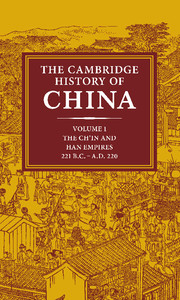Book contents
- Frontmatter
- Introduction
- 1 The state and empire of Ch'in
- 2 The Former Han dynasty
- 3 Wang Mang, the restoration of the Han dynasty, and Later Han
- 4 The conduct of government and the issues at stake A.D. 57–167
- 5 The fall of Han
- 6 Han foreign relations
- 7 The structure and practice of government
- 8 The institutions of Later Han
- 9 Ch'in and Han law
- 10 The economic and social history of Former Han
- 11 The economic and social history of Later Han
- 12 The religious and intellectual background
- 13 The concept of sovereignty
- 14 The development of the Confucian schools
- 15 Confucian, Legalist, and Taoist thought in Later Han
- 16 Philosophy and religion from Han to Sui
- Bibliography
- Glossary-Index
- Map 7 The Han empire, 143 b.c.
- Map 8 The Han empire, 108 b.c
- Map 9 The Han empire, a.d. 2
- Map 12 The Han empire, a.d. 140">
- References
14 - The development of the Confucian schools
Published online by Cambridge University Press: 28 March 2008
- Frontmatter
- Introduction
- 1 The state and empire of Ch'in
- 2 The Former Han dynasty
- 3 Wang Mang, the restoration of the Han dynasty, and Later Han
- 4 The conduct of government and the issues at stake A.D. 57–167
- 5 The fall of Han
- 6 Han foreign relations
- 7 The structure and practice of government
- 8 The institutions of Later Han
- 9 Ch'in and Han law
- 10 The economic and social history of Former Han
- 11 The economic and social history of Later Han
- 12 The religious and intellectual background
- 13 The concept of sovereignty
- 14 The development of the Confucian schools
- 15 Confucian, Legalist, and Taoist thought in Later Han
- 16 Philosophy and religion from Han to Sui
- Bibliography
- Glossary-Index
- Map 7 The Han empire, 143 b.c.
- Map 8 The Han empire, 108 b.c
- Map 9 The Han empire, a.d. 2
- Map 12 The Han empire, a.d. 140">
- References
Summary
When we speak of the development of the Confucian schools in the early phases of China's history, the various meanings of this term should be carefully distinguished. First of all, there is the concrete aspect of the word “school,” a rendering of the word chia which also means “home, family.” As schools began to develop toward the end of the Spring and Autumn period (fifth century B.C.), they consisted of a master, an intimate circle of disciples, and a greater number of students. It is highly likely that such schools originated in the need to instruct young nobles in the necessary arts of court life, to prepare them for the role they were to play as leaders of the community.
At the time of Confucius (the end of the sixth and the beginning of the fifth century B.C.), these arts consisted on the one hand of religious and civil accomplishments: ritual and music, and connected with them a knowledge of certain written traditions shared by most centers of power, especially the Book of songs and the Book of documents; and on the other hand they consisted of military skills, notably archery and charioteering. Such centers of instruction must have been attached to many of the larger courts of China at this time, and they must have been entirely dependent on the whims of those in power. Confucius too, despite traditions telling of his growing fame as a teacher, was during most of his active life a vassal in the service of the powerful Chi-sun family which furnished the virtual rulers of his home state, Lu.
- Type
- Chapter
- Information
- The Cambridge History of China , pp. 747 - 765Publisher: Cambridge University PressPrint publication year: 1986
References
- 3
- Cited by

